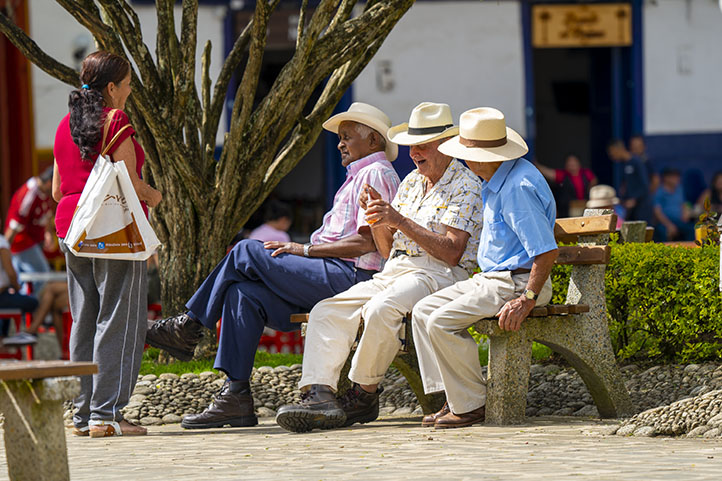Updated on 05/06/2024
Dear reader,
I would also like to recommend our Colombia travel guide, which provides a perfect overview of the tourist attractions in Colombia. Enjoy reading it!
Colombia is a beautiful country with a rich and diverse culture. But did you know that it also has a variety of languages spoken by its people? While Spanish is the official language of Colombia, it is not the only one. There are also many indigenous languages, creole languages, and foreign languages that are spoken in different regions of the country. In this blog, we will explore the language diversity in Colombia and give you some tips on how to communicate with the locals.
Content
ToggleHow Colombia Became a Spanish-Speaking Country
Colombia has more than 50 million people, who are mostly of mixed European and indigenous ancestry, or white. There are also some Afro-Colombians and Amerindians, who make up about 11% of the population.
But what language do they speak in Colombia? The official language is Spanish, which was brought by the Spanish colonizers who conquered the land and its native people. However, there are also many indigenous languages that are part of Colombia’s rich cultural heritage.
Before the Spanish Came: The Indigenous Cultures and Languages
Colombia was home to many different indigenous cultures for thousands of years before the Spanish arrived. Some of the oldest civilizations date back to 1,500 BC, such as San Agustin and Tierradentro. Over time, many groups emerged, migrated, and settled in various regions of Colombia.
By the 16th century, the most powerful and influential cultures were the Taironas and Muiscas, who belonged to the Chibcha language family. But there were many others who also contributed to the diversity and richness of Colombia’s culture and language.
The Spanish Conquest: How Spanish Became the Dominant Language
The first Spanish explorers landed on the Colombian coast in 1500, and soon began to move inland in search of gold and other riches. They founded the first city in 1525, and started to establish their colonies and settlements.
The Spanish conquest was a violent and brutal process that oppressed and displaced the indigenous people. Their villages were destroyed and their traditions were despised. Many native people died from diseases brought by the Europeans or from slavery and warfare. Their languages and cultures were gradually erased by the Spanish domination.
How did the Spanish communicate with the indigenous people? At first, they used signs and gestures, but that was not enough. The Spanish empire wanted to impose their language and religion as symbols of their power and prestige. So they used different strategies to make the natives learn Spanish and forget their own languages.
One strategy was to use interpreters, priests, and missionaries who learned some of the main indigenous languages, such as Muisca, Saliba, and Siona. They translated the Catholic teachings into these languages and tried to convert the natives to Christianity. They also introduced new words and concepts from Europe and Catholicism.
Another strategy was to isolate the children of the indigenous leaders (called Caciques) and teach them Spanish and European customs. They hoped that these children would influence their parents and communities to adopt the Spanish ways. Later, the church created boarding schools where children were raised under Catholic values and only allowed to speak Spanish.
From Independence to Modern Times: The Officialization of Spanish and Recognition of Indigenous Languages
These practices continued until the 18th century, when Spanish was the dominant language in urban areas and indigenous languages were only spoken in private or rural settings. Even Simon Bolivar, the leader of the independence movement from Spain in 1810, supported the officialization of Spanish as it was the common language in all of Latin America.
In 1886, the Constitution of Colombia declared Spanish as the official language of the country. It was not until 1991 that a new constitution recognized the indigenous languages as co-official in their respective regions. Today, there are about 65 indigenous languages spoken in Colombia, mostly by small groups of people who live in remote areas.
Spanish is still the main language of communication in Colombia, but it is also influenced by its indigenous roots. There are many words, expressions, and accents that reflect the diversity and history of Colombia’s language.
The amazing diversity of languages in Colombia
Did you know that Colombia is home to more than 70 languages? That’s right, this beautiful country is not only rich in natural resources, culture, and music, but also in linguistic diversity.
“According to the 2005 census of Colombia, the country has 37 major languages” (Translator without Borders).
However, in Colombia they speak 70 languages in total: Spanish and 69 native languages, among which there are 65 indigenous languages, 2 creole languages, Romani spoken by the Rom people and the Colombian sign language. Besides, experts say that there are more than 65 indigenous living languages.
Let’s dive into the main ones.
Spanish: the official language with many flavors
Spanish is the official language of Colombia and is spoken by 99.5% of the population. However, Colombian Spanish is not a uniform language. It has many regional variations or dialects that differ in pronunciation, intonation, and vocabulary. These dialects reflect the geographic and historical influences of the country, such as the colonization by different groups of Spaniards, the contact with indigenous and African languages, and the isolation or integration of some regions.
Did you know that in Bogota (central Colombia) people speak differently than in Medellin (western Andes), Cartagena (Caribbean coast), or Cali (Pacific region)? Or that on the coast you will hear more words of African origin, while in inland regions you will find more words from indigenous languages? Or that some Colombians use ‘tú’ while others use ‘vos’ to address someone informally?
For example, on the coast you will see hear more words of African origin such as banano, biche and ñame. While in inland regions such as Tolima, Boyacá and Cundinamarca there are more indigenous-based terms from the Muisca and Quechua languages. For example, changua, chingue, cubio or cancha, chocolo, chontaduro, minga, and ñapa, respectively.
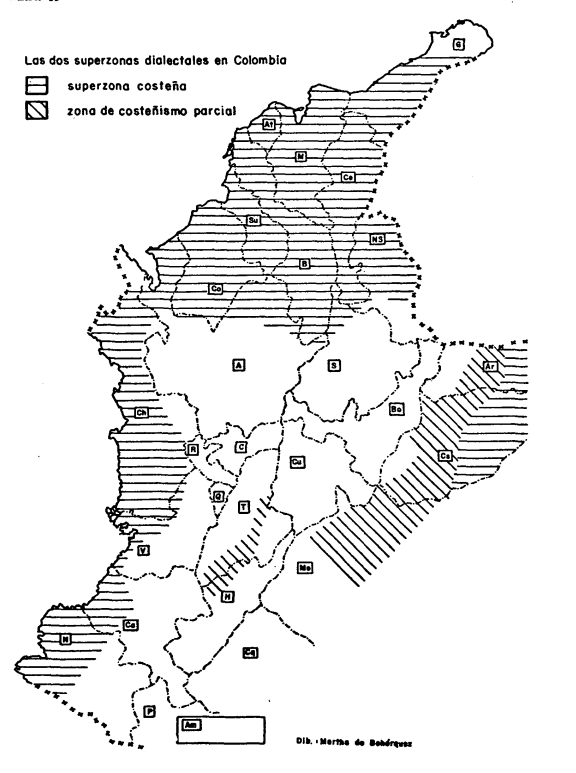
These dialects of course are formed by subdialects. So, in the Caribbean costeño we find the Cartagenero, Samario, Guajiro and Interior costeño, while the Pacific costeño has the northern and southern speeches. In turn, the Andean dialects include the variants Antioqueño-caldense (paisa), Nariñense-caucano, Tolimense-huilense, Cundiboyacense, and Santandereano. All of these use distinct vocabulary and intonation, so you will hear Paisas speaking with almost a melodical accent stretching the final sounds of words and Santanderanos have the stereotype of talking as if they were mad.
Also, our blog about slang in Colombia will be very useful for you to learn popular words of the Colombian region you’re visiting, so you can at least try to blend in.
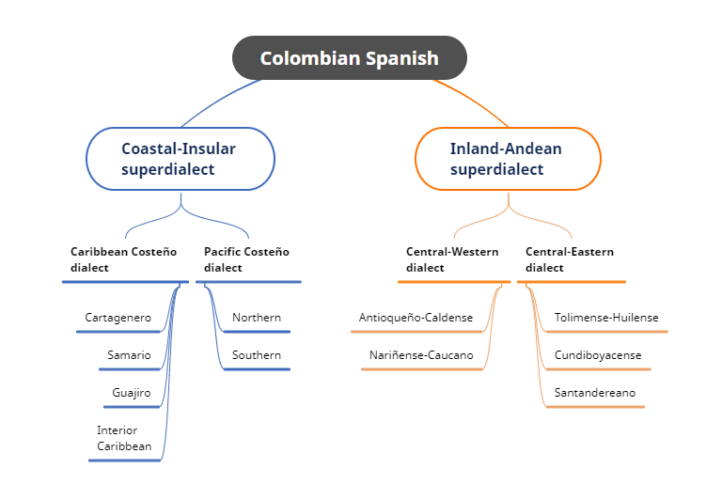
Indigenous languages: the endangered heritage of native peoples
Colombia is also home to 65 living indigenous languages that belong to different language families. These languages are spoken by over 60 indigenous communities that live in different regions of the country, from the Amazon rainforest to the Andean mountains. These languages are not only a way of communication, but also a way of expressing their culture, their worldview, their traditions, and their wisdom.
Unfortunately, most of these languages are at risk of extinction, as their speakers are threatened by physical and cultural violence, discrimination, assimilation, and loss of territory. According to a study by Los Andes University and the Colombian Center for Aboriginal Language Studies (CECELA), only 11 indigenous languages have more than 5,000 speakers, while 34 have less than 1,000 speakers.
| Number of speakers | Number of languages | Indigenous languages |
| +50,000 | 3 | Wayúunaki, Paez, Embera |
| 10,000 – 50,000 | 8 | Guahibo or Sikuani, Guambiano, Arhuaco or Ika, Inga, Ticuna (including speakers from Peru and Brazil), Tucano (including speakers from Brazil), Cuna (including speakers from Panama), Piaroa (including speakers from Venezuela) |
| 5,000 – 10,000 | 9 | Cuaiquer o Awá, Kogui, Waunana, Puinave, Wuitoto, Curripaco (including speakers from Venezuela), Piapoco (including speakers from Venezuela), Yaruro (more present in Venezuela), Yuco (including speakers from Venezuela) |
| 1,000 – 5,000 | 11 | Tunebo or U’wa, Cubeo, Camsá, Wiwa, Barí, Cofán, Cuiba, Coreguaje, Sáliba, Guayabero, Yagua (including speakers from Peru) |
| -1,000 | 34 | Totoró, barasano, desano, wanano, piratapuyo, achagua, andoke, bará, bora, cabiyarí, carapana, carijona, chimila, cocama, hitnu, macuna, cacua, nukak, hupda, yuhup, miraña, muinane, nonuya, ocaina, pisamira, siona, siriano, tanimuka, tariano, tatuyo, tinigua, tuyuca, yucuna, yurutí |
Therefore, preserving these languages is crucial to protect the diversity and richness of Colombia’s native peoples and their legacy. Here is a list of all the indigenous languages spoken in Colombia.
- Achagua
- Andoque (isolated)
- Awapit
- Bará
- Barasano
- Barí Ara
- Bora
- Cabiyari
- Carapana
- Carijona
- Cocama
- Cofán (isolated)
- Cuiba
- Curripaco
- Damana
- Desano
- Embera (Chami, Dodiba, Katío)
- Ette Naka / Ette Taara
- Hitnu
- Guayabero
- Ika
- Inga
- Kakua
- Kamsá (Isolated)
- Kichwa
- Kogui
- Koreguaje
- Kubeo
- Kuna Tule
- Macuna
- Miraña
- Muinane
- Namtrik
- Nasa-Yuwe (unclassified)
- Nonuya
- Nukak
- Ocaina
- Piapoco
- Piaroa
- Piratapuyo
- Pisamira
- Puinave
- Sáliba
- Sikuani
- Siona
- Siriano
- Taiwano
- Tanimuca
- Tariano
- Tatuyo
- Tikuna (isolated)
- Tinigua-bamigua (isolated, almost extinct)
- Tucano
- Tucuná
- Tuyuca
- Uitoto
- U’wa
- Wanano
- Wayuunaiki
- Wounaan / Woun Meu
- Yagua (isolated or unclassified)
- Yanuro / Yaruro
- Yuhup
- Yukpa
- Yuruti
Over 400,000 people speak these languages in 30 of 32 departments (ONIC), especially in border and rural areas of the country.
Remember that experts affirm that there are over 65 indigenous living languages today and let’s not count those that got extinct for different reasons.
Linguists classify them in 13 different language families and group 7 languages as isolated or unclassified.
- Chibcha
- Arawak
- Guahibo
- Tucano Oriental
- Chocó
- Caribe
- Sáliba-Piaroa
- Macú-Puinave
- Bora
- Uitoto
- Tupí-Guaraní
- Quechua
- Andino Ecuatorial
Creole languages: the result of mixing and resistance
Another type of language spoken in Colombia is creole language. Creole languages are created when people from different origins need to communicate with each other and mix elements from two or more languages. Usually, one of these languages is dominant or imposed by a colonizer or a slave owner.
In Colombia, there are two creole languages: San Andresan Creole and Palenquero. San Andresan Creole is spoken on the islands of San Andres and Providencia by an Afro-Caribbean ethnic group called Raizal. It has an English lexical base with influences from Spanish and African languages. Palenquero is spoken in San Basilio de Palenque, a small town founded by runaway slaves in the colonial era. It has a Spanish lexical base with influences from African languages, especially from the Bantu family.
These creole languages are not only a product of mixing languages, but also a form of resistance and identity for their speakers. They represent their history of struggle for freedom and recognition as ethnic groups in Colombia.
San Andres Creole
The San Andres and Providencia archipelago is located in the Caribbean Sea, closer to Nicaragua (120 mi) than Colombia (450 mi) but belongs to Colombia’s territory.
Its inhabitants belong to an Afro-Caribbean ethnic group called Raizal and speak San Andresan Creole.
The base of its native language is English, similar to other creoles in the Caribbean. So, it is also known as Creole English and islander.
History
The African slaves brought by European colonists to several islands in the Caribbean created a code to be able to communicate with their peers and masters. This code called “pidgin” emerged in Jamaica and later arrived in the islands of San Andres, Providencia, and Santa Catalina.
Since 1630, English and Dutch colonizers settled in the islands of San Andres and Providencia. That’s why the San Andresan creole has an English lexical base. In fact, in the beginning, creole speakers also spoke, read, and wrote in standard English.
Today, natives of the San Andres archipelago can be considered trilingual, as English, Spanish and Creole are official languages and people speak one or another depending on their background and the environment or who they are talking with.
Palenquero
San Basilio de Palenque is a small town in the Bolivar department, about 40 miles from Cartagena, that was founded by runaway slaves in the colonial era. It is actually considered the first free town in colonial America and for that, it was recognized as an intangible cultural heritage of humanity by UNESCO in 2005.
Inhabitants of Palenque, which today are around 4,000, speak Palenquero. This is a creole language with a Spanish lexical base and a strong influence of the Bantu language family from Africa, specifically of the Kikongo and Kimbundu. It shares about 200 words with kikongo language. It is also influenced by Portuguese.
Moreover, Palenquero is currently the only Spanish-based creole language spoken on the American continent.
History
The San Basilio Palenque was one of those remote places where ‘cimarrones’ or runaway slaves escaped from Cartagena to live in freedom. After failed peace treaties that were violated by the Spanish, the Palenque was legalized and recognized as a free town by the end of the 17th century.
Being an isolated community, they have managed to keep their African cultural traditions in ceremonies, medicine, and music.
Sadly, according to the portal of languages of Colombia, the Palenquero language was for a long time stigmatized by fellow Colombians and seen as a bad spoken Spanish. So inside the community, the mother tongue was partly replaced by Spanish in most contexts and children were even being educated in Spanish, losing mastery of Palenquero.
However, since the 80s, thanks to some ethnic-educational projects, the community of Palenqueros of San Basilio now proudly promotes its creole language as their identity symbol.
Romani: the language of nomads
Romani is the language spoken by the Romani or Roma communities, also known as gypsies. The Roma people are originally from northeast India and have a nomadic lifestyle that has spread them across the world.
In Colombia, there are about 5,000 to 8,000 Roma people who arrived since the colonial times. They speak two varieties of Romani: Romani and Rumeniaste. Romani is spoken by the Rom population that lives mainly in Barranquilla, Bogota, Cali, Cartagena, Cucuta, Giron, Itagui, Pasto y Sogamoso. Rumeniaste is spoken by the Ludar gypsy community located in Cucuta and some parts of the Atlantic coast.
Romani belongs to the Indo-Aryan language subfamily within the Indo-European family. It has many influences from other languages depending on where the Roma people have lived or migrated.
Colombian sign language: the language of the deaf community
Last but not least, Colombia has its own sign language used by the deaf community. Sign language is not universal, it varies depending on the groups or communities of deaf people that create it. Colombian sign language was officially recognized in 1996 and has its own grammar and pragmatics rules. Spanish is the second language of the deaf community in Colombia.
There are some organizations that promote and support the Colombian sign language, such as the National Federation of the Deaf of Colombia (Fenascol) and the National Institute for the Deaf (INSOR). They have published manuals and dictionaries of Colombian sign language that you can download here.
How to Explore the Diversity of Languages in Colombia
Colombia is a country rich in linguistic diversity. Besides Spanish, which is the official language spoken in all its territory, there are many other languages that reflect the cultural heritage of its people. Some of these languages are official in certain regions, such as English in San Andres Archipelago and the native languages in the areas where they are spoken. In fact, there are more than 60 native languages in Colombia, belonging to different families and groups.
If you are curious about these languages and where they are spoken, you can check out this amazing map made by Translators without Borders, a nonprofit organization that works to provide access to information and communication in different languages. The map shows the most spoken languages in Colombia (excluding Spanish) and how they are distributed across the country.
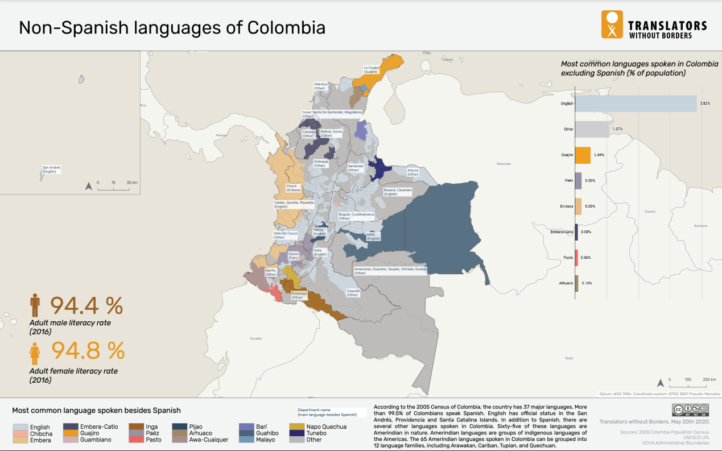
As you see, apart from English and other unspecified languages, the Guajiro or Wayuunaki in La Guajira, Paez in Cauca and Embera in Choco are the most popular languages after Spanish, spoken by native cultures.
The data is from the 2005 census, though, so it may be outdated but gives you a general idea.
For example, by selecting the Embera language on the left menu, you can see highlighted in blue where in the map it is spoken, in the bottom it shows the number of speakers and when you hover over any of the territorial divisions of the country, a box dialog will show you what percentage of the population in that area speaks the selected language, which is the non-Spanish primary language there and the literacy rate. Amazing, isn’t it?
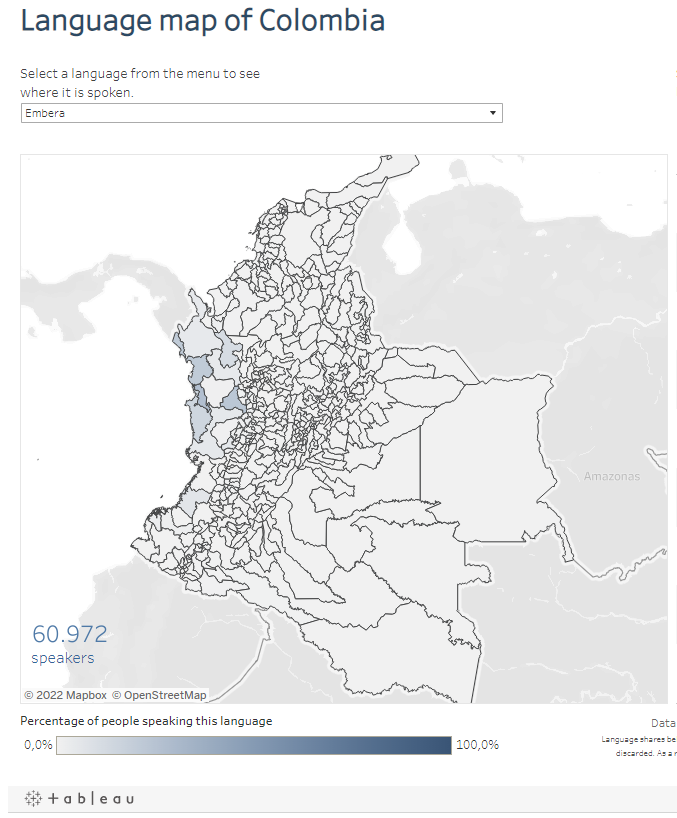
Then, in the right column, if I select Bogota, it shows me that 100% of the population speaks Spanish, almost 8% speaks English, 1.3% French, and so on.
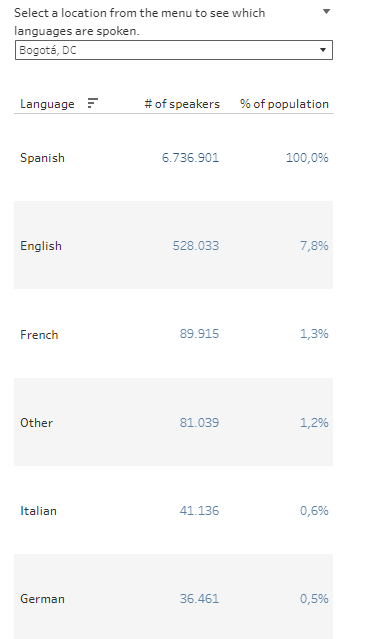
While in Inirida and other towns of the Guainia department, you see a new language, Guahibo, spoken by 15% of the population.
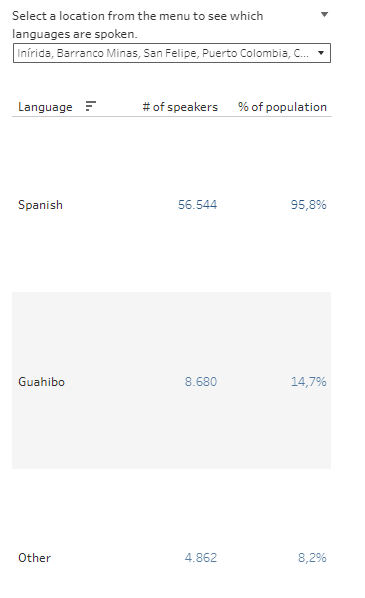
Fun facts about languages in Colombia
- Colombians, particularly people from Bogotá, have a reputation for speaking the best or most neutral Spanish. But there is no such thing as neutral Spanish, besides that created for voiceovers and dubbing in Latin America. What happens is that the accent of Bogota is clear and easily understandable.
- The name of the country comes after the explorer Christopher Columbus.
- On February 21st it’s the National Day of Native Languages in Colombia and the International Day of Mother Tongue.
- Some names of districts in Bogota and surrounding towns come from the extinct Muisca language, mhuysqhubun: Timiza, Bosa, Chucua, Tunjuelito, Usaquén, Soacha, Suba, Fontibón, Teusaquillo, Bochica, Bachue, Chía, Fusa, Cota, Zipaquirá, Tunja. The native language was spoken in the Cundiboyacense plateau got extinct by the 18-19th
- The native singer from San Andres Elkin Robinson has made it to the radio and national music industry with its music in creole, something uncommon for native music.
- The Basic Dictionary of Colombian Sign Language has a base vocabulary of 1,200 entries.
- The Ministry of Culture, along with other institutions and in agreement with native communities, has translated several laws and legal documents to their own languages so that they can access information key to guarantee their rights. The greatest work of translation was the Peace agreement, available written in 45 languages and audible in 16 languages.
- Colombian Gabriel García Márquez is a Literature Nobel Prize thanks to his novel “One hundred years of solitude”.
Differences between Spanish in Colombia and other countries
Spanish is a language that has many varieties and dialects, depending on the region and the country where it is spoken. Colombian Spanish is not a uniform dialect, but rather a group of varieties that share some common features and differ from other Spanish-speaking countries in several aspects. Some of the main differences are:
- Pronunciation: Colombian Spanish tends to pronounce the letters “z” and “c” (before “e” or “i”) as “s”, while other countries, especially Spain, pronounce them as “th”. For example, the word “zapato” (shoe) sounds like “sapato” in Colombia, but like “thapato” in Spain. Colombian Spanish also pronounces the letters “ll” and “y” as “j”, while other countries, such as Argentina and Uruguay, pronounce them as “sh”. For example, the word “llave” (key) sounds like “jave” in Colombia, but like “shave” in Argentina.
- Vocabulary: Colombian Spanish has many words and expressions that are unique to its culture and history, and that may not be understood by speakers from other countries. For example, Colombians use the word “parce” or “parcero” to refer to a friend or buddy, while other countries use words like “amigo”, “compañero”, or “colega”. Colombians also use the word “chévere” to mean cool, awesome, or great, while other countries use words like “guay”, “genial”, or “bueno”.
- Accent: Colombian Spanish has different accents depending on the region and the social class of the speaker. The most prestigious and standard accent is considered to be the one spoken in Bogotá, the capital city, which is clear and neutral. The accent of the northern coastal area is influenced by Caribbean Spanish and has features such as dropping the final consonants of words, aspirating the letter “s”, and using intonation to express emotions. The accent of the western area is influenced by Andean Spanish and has features such as pronouncing the letter “r” as a trill or a flap, using diminutives to express affection or politeness, and using words from indigenous languages.
Where to learn Spanish and native languages of Colombia?
Colombia is a very attractive destination for Spanish learners because of its reputation for speaking the best Spanish in the world. Whether this is true or not, there are many high-quality institutions that offer courses to learn this romance language.
According to Colombia.co, the country brand, over 2000 people travel each year to learn Spanish in Colombia. The most obvious choice is Bogota because it has many prestigious universities with qualified courses.
For example, the National University, public and the #1 in the country; Los Andes, Javeriana, among other universities. Also, Instituto Caro y Cuervo is an absolute authority in the teaching of Spanish as a foreign language, literature, and native Colombian languages!
If you don’t feel like living in the capital, Colombia is so diverse that you can choose the city you want to learn in depending on the weather, sights, and cultural traditions you’re most interested in.
Or, if you prefer to study the language from your couch before traveling, there are incredible platforms that will make your learning process easier and fun as well.
And what about the native languages of Colombia? Well, if you want to learn them, you will have to find a native speaker who can teach you or look for online resources that can help you. Some websites that offer information and materials about these languages are:
- Lenguas de Colombia: A website created by Instituto Caro y Cuervo that provides information about the linguistic diversity of Colombia and its native languages.
- Etnolinguistica: A website that collects academic papers and documents about indigenous languages and cultures in South America.
- Proel: A website that promotes linguistic diversity and offers maps, grammars, and dictionaries of many languages around the world.
More about Colombian Culture
- Colombia’s 45 Best & Biggest Festivals in Detail
- The 7 Most Terrifying Legends of Colombia
- 31 Colombian Dishes and Food From All Regions You Should Try
- Beyond Hola: Insider’s Guide to Colombian Customs
- How Many Languages are Spoken in Colombia? A Comprehensive Language Guide
- Complete Colombian Slang Guide: Essential Words for Your Trip to Colombia
- Your Ultimate Guide to Spanish Travel Phrases: Solve all Situations

